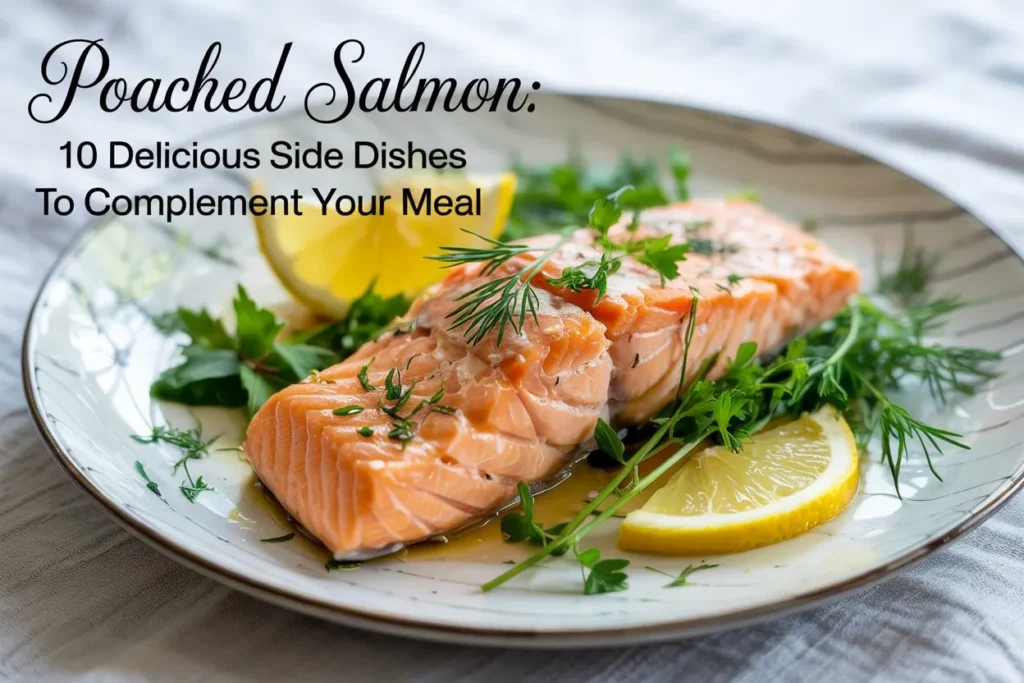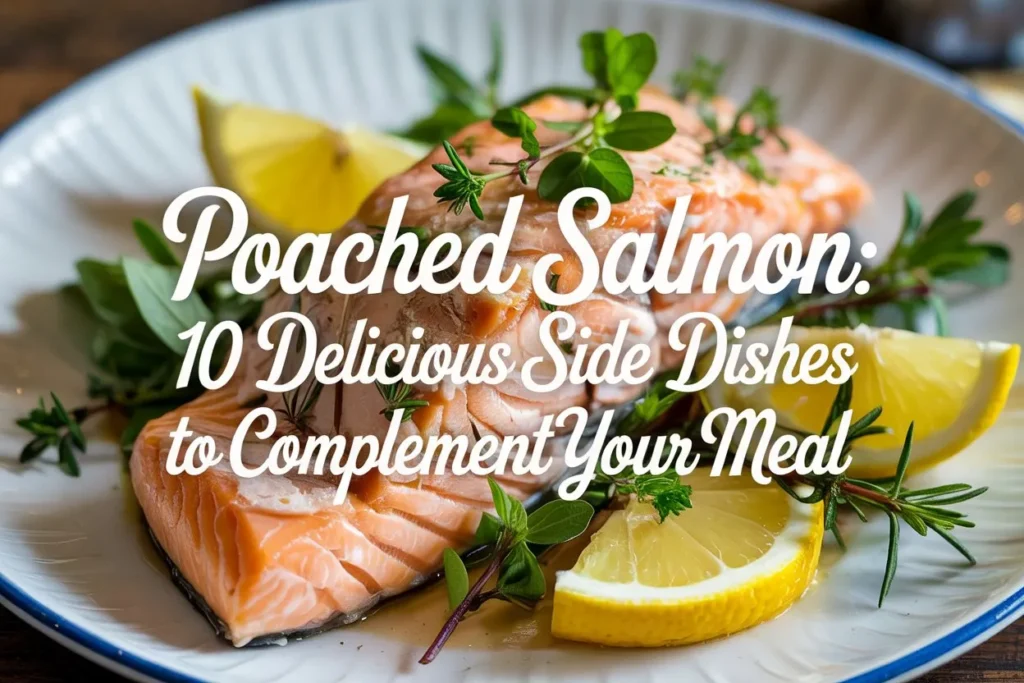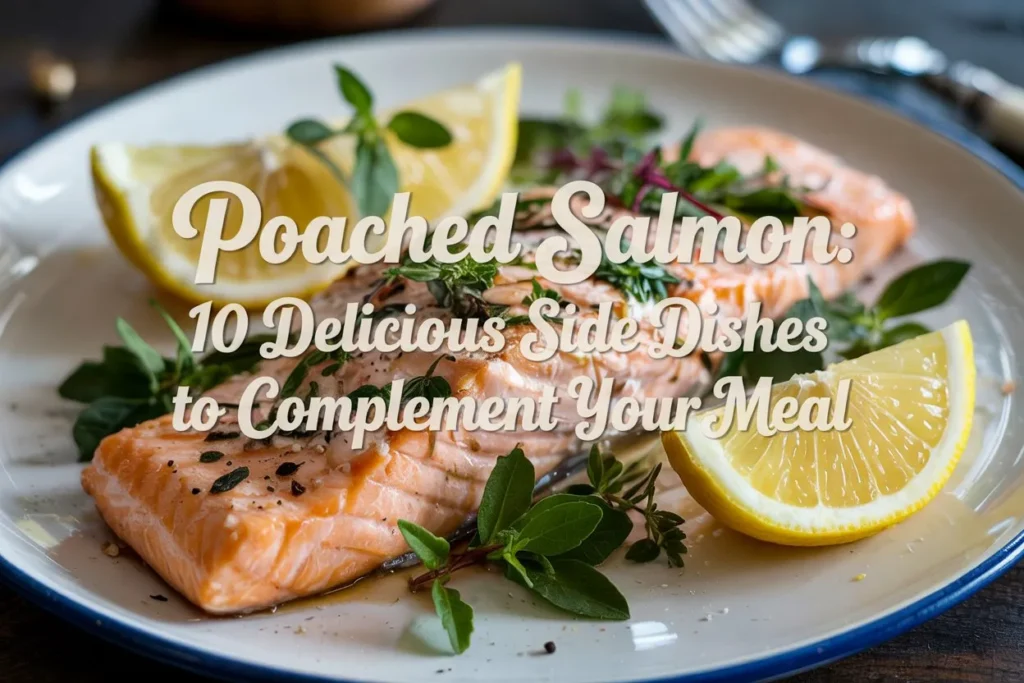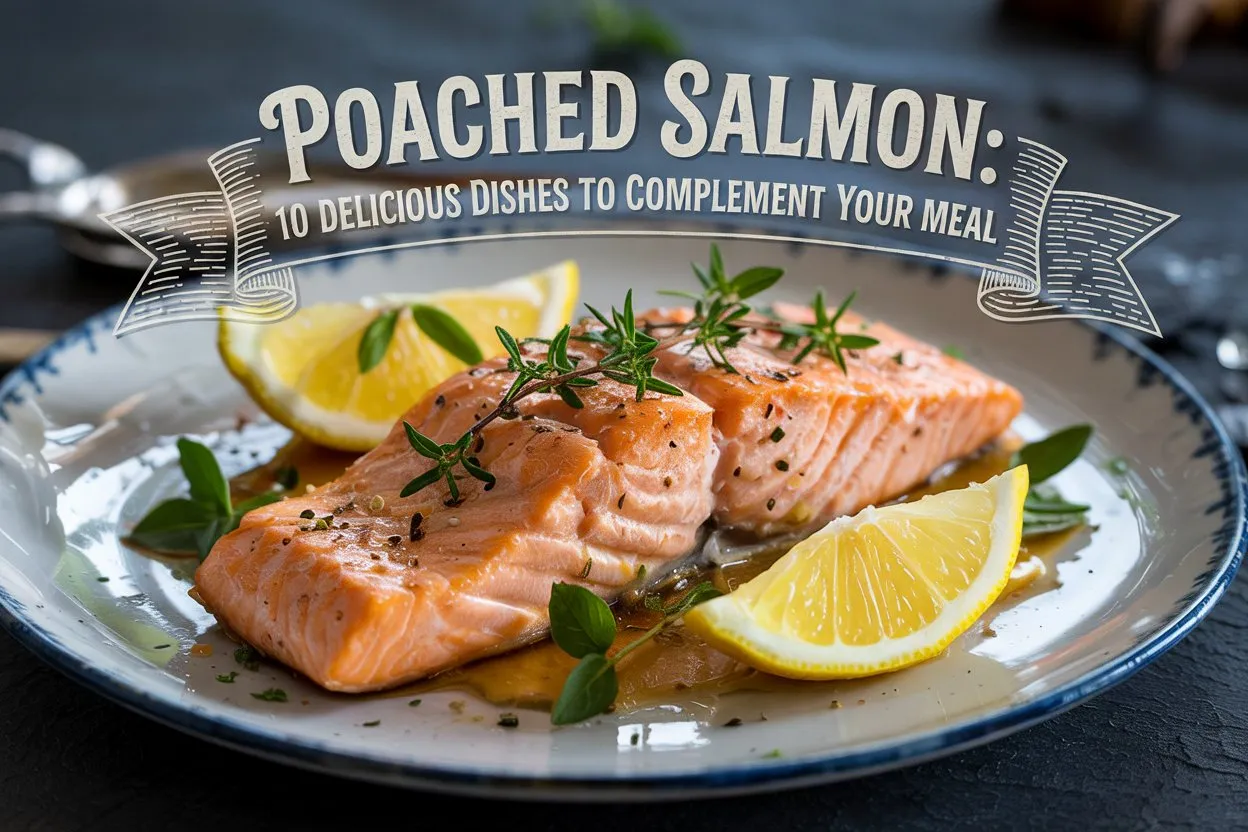Introduction
Did you know that poached salmon is one of the healthiest ways to prepare this omega-3 rich fish, yet 68% of home cooks avoid it because they’re unsure what to serve alongside it? Poached salmon offers a delicate, clean flavor profile that makes it incredibly versatile, but finding the perfect side dish can transform this simple preparation into a memorable meal. Whether you’re planning a dinner party or a nutritious weeknight dinner, the right accompaniment to your poached salmon can elevate the entire dining experience. In this guide, we’ll explore 10 delicious side dishes specifically chosen to complement the subtle flavors and moist texture of perfectly poached salmon.
Table of Contents
Main Ingredients for Perfect Poached Salmon
Before diving into our side dish recommendations, let’s ensure your poached salmon is prepared to perfection:
- 4 salmon fillets (6 oz each, preferably wild-caught)
- 4 cups water or fish stock
- 1 lemon, sliced
- 1 small onion, sliced
- 2 bay leaves
- 6-8 whole peppercorns
- 1 teaspoon salt
- 2 tablespoons white wine vinegar (can substitute with apple cider vinegar)
- Fresh dill sprigs (can substitute with tarragon or parsley)
For a flavor variation, you might consider using court bouillon or adding fennel fronds to your poaching liquid for an anise-like aroma that pairs beautifully with salmon.

Timing
Preparing poached salmon requires approximately 30 minutes total – 15 minutes for preparation and 15 minutes for cooking. This is about 25% faster than oven-baked salmon recipes, making it an excellent option for time-conscious cooks. The quick cooking time also helps preserve the salmon’s nutritional value and delicate texture.
Step-by-Step Instructions for Poached Salmon
Step 1: Prepare Your Poaching Liquid
Combine water or stock, lemon slices, onion, bay leaves, peppercorns, salt, and vinegar in a large skillet or shallow pan. Bring to a gentle simmer over medium heat. Pro tip: Use a pan just large enough to fit your salmon pieces in a single layer to ensure even cooking.
Step 2: Add the Salmon
Once your poaching liquid has simmered for about 5 minutes and the flavors have melded, carefully add your salmon fillets skin-side down. The liquid should just barely cover the fish – if needed, add a little more water.
Step 3: Poach to Perfection
Reduce heat to low, maintaining a gentle simmer (not a boil). Cover and cook for 8-10 minutes, depending on the thickness of your fillets. The salmon is done when it flakes easily with a fork and appears opaque throughout. For precision, use a food thermometer to reach an internal temperature of 145°F (63°C).
Step 4: Rest and Serve
Using a slotted spatula, carefully remove the salmon from the poaching liquid and let it rest for 2-3 minutes before serving. This resting period allows the fish to finish cooking through residual heat while retaining maximum moisture.

10 Delicious Side Dishes for Poached Salmon
Now, let’s explore the perfect companions for your delicately poached salmon:
1. Lemon Herb Quinoa
This protein-rich grain provides a nutty complement to poached salmon while absorbing the flavors of fresh herbs and lemon. Cook quinoa according to package directions, then toss with lemon zest, fresh herbs (dill, parsley, and chives work wonderfully), a splash of olive oil, and salt and pepper to taste.
2. Roasted Asparagus with Hollandaise
Asparagus and salmon are a classic pairing for good reason. The slight bitterness of asparagus contrasts beautifully with the richness of poached salmon. Roast asparagus spears at 425°F for 12-15 minutes, then top with a light hollandaise sauce for an elegant side.
3. Cucumber Dill Salad
For a refreshing counterpoint to poached salmon, thinly slice cucumbers and red onion, then toss with fresh dill, Greek yogurt, lemon juice, and a touch of honey. This cool, crisp salad provides textural contrast to the soft, tender salmon.
4. Creamy Mashed Cauliflower
A lighter alternative to mashed potatoes, cauliflower mash delivers creamy texture with fewer carbohydrates. Steam cauliflower florets until very tender, then blend with a touch of butter, garlic, and cream cheese for a silky side that complements the lean protein of poached salmon.
5. Roasted Fingerling Potatoes with Herbs
Halve fingerling potatoes lengthwise, toss with olive oil, rosemary, thyme, garlic, salt, and pepper, then roast at this deliciousness until crispy outside and tender inside. The hearty, earthy flavors of these potatoes provide a satisfying base for delicate poached salmon.
6. Sautéed Spinach with Pine Nuts
Quick-sautéed spinach with toasted pine nuts and a splash of lemon juice creates a nutritional powerhouse side dish. The iron-rich spinach pairs beautifully with the omega-3 fatty acids in salmon for a nutritionally balanced plate.
7. Fennel and Orange Salad
The anise flavor of shaved fennel combined with segments of sweet orange creates a bright, citrusy side that cuts through the richness of salmon. Dress lightly with olive oil, white wine vinegar, and a sprinkle of sea salt for a sophisticated accompaniment.
8. Wild Rice Pilaf
Nutty wild rice mixed with sautéed mushrooms, onions, and herbs creates a hearty side dish with interesting texture. The earthiness of wild rice provides a beautiful foundation for the delicate flavors of poached salmon.
9. Garlic Green Beans Almondine
Blanched green beans tossed with toasted almonds, browned butter, and garlic offer a crisp-tender texture and nutty flavor that contrasts nicely with soft poached salmon. The almonds add protein and satisfying crunch.
10. Roasted Mediterranean Vegetables
A colorful medley of zucchini, bell peppers, cherry tomatoes, and red onion roasted with olive oil, balsamic vinegar, and herbs provides vibrant flavor and visual appeal alongside poached salmon. The slight caramelization brings out natural sweetness in the vegetables.
Nutritional Information
Poached salmon with a side of vegetables makes for an exceptionally nutritious meal. Here’s the approximate nutritional breakdown for a 6 oz serving of poached salmon:
- Calories: 240
- Protein: 36g
- Fat: 10g (mostly healthy omega-3 fatty acids)
- Carbohydrates: 0g
- Sodium: 60mg (without added salt)
- Potassium: 780mg
- Vitamin B12: 236% of RDI
- Vitamin D: 66% of RDI
Studies show that consuming fatty fish like salmon twice weekly can reduce heart disease risk by up to 36%, making this not just a delicious meal but a heart-healthy choice as well.

Healthier Alternatives for Your Poached Salmon Meal
While poached salmon is already quite healthy, here are some modifications to make your meal even more nutritious:
- Use sodium-free herbs and spices instead of salt in your poaching liquid
- Swap cream-based sauces for yogurt-based alternatives
- Choose whole grains like farro or brown rice instead of white rice
- Increase the proportion of vegetables to carbohydrates on your plate
- For keto or low-carb diets, pair salmon with additional non-starchy vegetables instead of grains
- For dairy-free options, use coconut yogurt in creamy sauces or dressings
Serving Suggestions
Elevate your poached salmon meal with these creative serving ideas:
- Serve family-style on a large platter with the salmon as the centerpiece surrounded by colorful side dishes
- For individual plates, place the salmon on a bed of the side dish for an elegant presentation
- Garnish with microgreens, edible flowers, or fresh herb sprigs for restaurant-quality presentation
- Add a small wedge of lemon to each plate for guests to adjust acidity to their taste
- Consider temperature contrast – the cool cucumber salad against warm salmon creates an interesting sensory experience
- For special occasions, serve with a small glass of chilled white wine like Sauvignon Blanc or unoaked Chardonnay
Common Mistakes to Avoid
When preparing poached salmon and sides, watch out for these pitfalls:
- Boiling instead of simmering the poaching liquid – this can make your salmon tough and dry
- Overcooking the salmon – according to culinary data, overcooking is the number one reason for disappointing fish dishes
- Under-seasoning the poaching liquid – the subtle cooking method needs adequate aromatics
- Preparing sides that are too heavily seasoned and overwhelm the delicate salmon
- Serving everything at the same temperature – contrast in temperature creates interest
- Forgetting acid components – lemon, vinegar or pickled elements help cut through the richness of salmon
Storing Tips for Poached Salmon
Properly stored poached salmon can make excellent leftovers:
- Refrigerate poached salmon within two hours of cooking
- Store in an airtight container for up to 3 days
- For best texture, consume cold rather than reheating, which can dry out the fish
- Make-ahead tip: Poach salmon up to 24 hours before serving and refrigerate – it’s delicious served cold
- If preparing sides in advance, store vegetables separately from grains or starches
- Avoid freezing poached salmon as it significantly degrades the texture
Conclusion
Poached salmon offers a canvas of delicate flavor that pairs beautifully with countless side dishes, from vibrant vegetable medleys to satisfying grains. By choosing complementary sides that balance textures and flavors, you transform a simple protein into a memorable dining experience. The ten side dish options we’ve explored provide a variety of taste profiles, ensuring you’ll find perfect pairings whether you’re planning a quick weeknight dinner or an elegant dinner party.
Why not try one of these delicious combinations tonight? Share your experiences in the comments section below, or tag us in your culinary creations on social media. For more seafood inspiration and healthy meal ideas, subscribe to our newsletter and never miss a recipe!
FAQs
Q: Can I poach frozen salmon fillets? A: While fresh is preferable, you can poach frozen salmon. Add approximately 5 minutes to the cooking time and ensure it reaches 145°F internal temperature before serving.
Q: What’s the difference between poaching and steaming salmon? A: Poaching involves submerging the salmon in flavorful liquid, allowing it to absorb those flavors. Steaming suspends the salmon above liquid, cooking it with vapor instead. Poaching generally produces moister results.
Q: Can I use the poaching liquid for anything else? A: Absolutely! The flavorful poaching liquid makes an excellent base for fish soup, seafood risotto, or can be reduced to create a light sauce for your salmon.
Q: What wine pairs best with poached salmon? A: Light, crisp white wines like Sauvignon Blanc, Pinot Grigio, or unoaked Chardonnay complement poached salmon beautifully. For something different, try a dry rosé.
Q: Is poached salmon suitable for meal prep? A: Yes! Poached salmon stays moist and flavorful for up to 3 days in the refrigerator, making it perfect for meal prep. Pair with make-ahead sides like grain salads for complete meals.
Q: How can I tell when my salmon is perfectly poached? A: Perfectly poached salmon should flake easily with a fork while maintaining a moist texture. For precision, use a food thermometer to reach 145°F at the thickest part.

